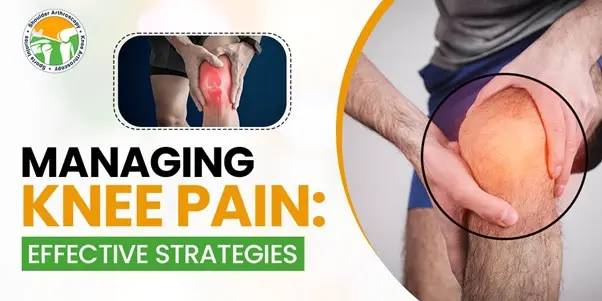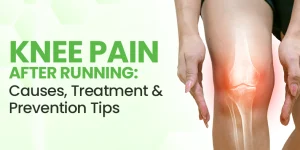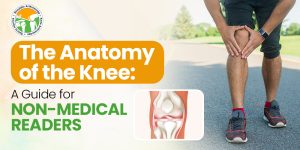Knee pain is quite common and can happen due to different reasons. Sometimes it goes away with rest, but other times it can get worse if you don’t take care of it. So, when your knee hurts, there are things you can do to feel better and avoid making it worse. This blog talks about effective steps in Managing Knee Pain. Here you would get information on what you should and shouldn’t do when dealing with knee pain.
About Knee Pain
Knee pain as the name suggests is when a patient feels discomfort or pain in or around your knee joint. The knee joint is a complex structure that links your thigh bone (femur) to your shin bone (tibia). It’s supported by ligaments, tendons, muscles, and cartilage. Knee pain is something many people experience, regardless of age. It can begin suddenly, often after an injury or exercise. Sometimes, it starts as a mild discomfort and gradually becomes more severe over time.
Structure of the knee joint
The knee, the largest joint in your body. It consists of these primary components:
- Bones
- Ligaments
- Cartilage
- Tendon
- Muscles
- Joint Capsule
- Bursa
| Knee Structure Components | Explanation |
| Bones | The knee joint is formed where three bones meet: the thigh bone (femur), shinbone (tibia), and kneecap (patella). |
| Ligaments | Ligaments join bones to other bones, providing stability to the knee. There are two types:
|
| Cartilage | Cartilage serves as a protective covering and shock absorber for the knee.
|
| Tendons | Tendons connect muscles to bones, allowing muscles to move the knee joint. |
| Muscles | Quadriceps and hamstrings are the main muscles that strengthen the leg and help in knee movement. |
| Joint Capsule | A membrane bag surrounding the knee joint, filled with synovial fluid that lubricates and nourishes the joint. |
| Bursa | Small fluid-filled sacs around the knee joint that reduce friction between knee tissues and prevent inflammation. |
Learn about the causes of knee pain
Knee pain can happen because of various reasons, like injuries, overuse, aging, or certain health conditions. Here are some common causes of knee pain explained in the table:
| Cause | Description |
| Injuries | Traumatic incidents such as fractures, dislocations, ligament tears (e.g., ACL or PCL tears), meniscus tears, or tendon injuries. |
| Arthritis | Different types of arthritis including osteoarthritis (wear-and-tear arthritis), rheumatoid arthritis (an autoimmune condition), and gout. |
| Tendonitis | Inflammation or irritation of tendons around the knee, such as patellar tendonitis (jumper’s knee) or quadriceps tendonitis. |
| Bursitis | Inflammation of the bursae, small fluid-filled sacs that cushion the knee joint. |
| Torn Meniscus | A tear in the meniscus, the cartilage that cushions the knee joint, leading to pain, swelling, and limited mobility. |
| Overuse/Repetitive Strain | Activities involving repetitive movements or excessive stress on the knee joint, such as running, jumping, or kneeling. |
| Alignment Issues | Problems with the alignment of leg bones, such as knock knees (valgus) or bow legs (varus), contributing to knee pain. |
When to contact a doctor:
Here are some signs to contact your Dr. Siddharth Aggarwal for managing knee pain:
- You experience severe pain, even without putting weight on it.
- You experience pain, swelling, numbness, tingling, or bluish discoloration in the calf below the affected knee.
- You can’t put weight on your knee.
- Your knee looks deformed or misshapen.
- Your pain persists after three days of home treatment.
- You have difficulty bending or straightening your knee fully.
- You notice a fever, redness, warmth, or a lot of swelling around the knee.
- Your knee feels unstable, clicks, or locks.
Diagnosis Of Knee Problems
Physical Examination
During the examination, the doctor will:
- Observe the patient’s knee for signs of swelling, pain, tenderness, warmth, and visible bruising.
- Evaluate the range of motion of the patient’s lower leg in different directions.
- Apply pressure to assess the strength and health of the knee structures.
Imaging Tests
Before proceeding with Knee Surgery (if needed), the doctor may recommend the following tests:
- X-ray: This initial imaging test helps identify broken bones or age-related joint issues.
- Computerized Tomography (CT) Scan: CT scans provide detailed images of bone structures and can detect small fractures or conditions like gout.
- Ultrasound: Real-time ultrasound imaging shows soft tissues around the knee and can reveal specific issues when the knee is moved into different positions.
- Magnetic Resonance Imaging (MRI): MRI scans create 3D images of the knee’s internal structures, making it useful for detecting injuries in ligaments, tendons, cartilage, and muscles.
Lab Tests
If there is suspicion of infection or inflammation, blood tests may be done. Additionally, arthrocentesis (joint fluid aspiration) may be performed. This involves the extraction of a small amount of knee joint fluid for lab analysis.
Managing Knee Pain: Effective Strategies
Managing Weight for Joint Health
Excess body weight increases the risk of developing joint pain and can exacerbate existing discomfort. Shedding even a small amount of weight can significantly alleviate knee pain.
Physical Therapy for Knee Pain
Enlisting the expertise of a skilled physical therapist can offer significant relief for knee pain sufferers. Through tailored exercise regimens, focusing on muscle strengthening and flexibility enhancement, physical therapy aims to improve joint function and alleviate discomfort. Activities like swimming, cycling, or elliptical training, recommended by therapists, are low-impact and aid in knee healing while reducing joint stress.
Balancing rest and exercise
Balancing rest and exercise is important in managing knee problems effectively.
- Initial 24 to 48 hours
In the initial 24 to 48 hours following the start of knee discomfort, it is essential to prioritize rest. However, patients should also incorporate gentle movement. During this period, resting the knee is advised. Doctors also advise that it is important to avoid prolonged periods of immobility as well. When the patient is awake, gentle knee movements for short intervals of 10 to 20 seconds every hour can promote circulation and flexibility.
- After the initial 48 hours
After the initial 48 hours, gradually increase leg activity. Doctors encourage their patients to do so as exercise. This can contribute to long-term pain relief and overall good knee health.
When a patient climbs stairs, leading with the unaffected leg while utilizing handrails for support is suggested. This can help reduce strain on the sore knee.
Returning to a patient’s normal routine, including work commitments, is recommended whenever feasible. This can aid in the recovery process and support overall well-being.
Change activities
There are a few activities that can worsen the patient’s knee pain. Without knowing which activities to do during knee pain one can, in fact, worsen or further damage the joint or knee. If the patient engages in high-impact sports or activities there is a high chance of mishap. Instead one can modify or replace them with low-impact alternatives. For example, patients can do exercise like swimming or practicing yoga. These activities can be gentle on the knees while at the same time they provide exercise and mobility benefits.
RICE method
When your knee hurts, it is important to give it plenty of rest so it can heal. Use the RICE method for managing knee pain:
- Rest
- Ice
- Compression
- Elevation
Rest means avoiding activities that make the pain worse. Putting ice on your knee can help with swelling and make it feel better. Make sure to wrap the ice pack in a towel or use one with a cover to protect your skin. Elevate the injured area on pillows while applying ice as this will help reduce swelling. Also, ensure the injured part remains at or above heart level whenever seated or lying down.
Different temperature for relief
Experimenting with different temperatures can effectively alleviate knee pain. During the initial days after a knee injury, when pain and swelling are noticeable, using a cold pack is advisable. It can be helpful in reducing swelling. It also helps relieve discomfort associated with the injury.
Apply the cold pack to the affected area for a few minutes, repeating this process 3-4 times a day. As the initial swelling subsides, switch to applying heat using a heating pad or warm towel, which can provide soothing relief. Continue alternating between cold and hot treatments regularly to manage knee pain effectively.
Supportive Devices
It is also good to use assistive devices/ supportive devices or knee caps for managing pain in the knee. These supportive devices are meant to provide additional support as well as stability to the knee joint. These products can help to reduce pain and swelling. Infact, these devices can also help prevent injury. We would advise patients to consult with the best orthopedic doctor for the right support device. A doctor can help in selecting the best suitable brace, Knee Caps, etc. as per patient’s specific condition.
Upgrade Your Footwear for Comfort and Support
Worn-out or ill-fitting shoes cause foot and leg pain. Choose supportive footwear with cushioned insoles to prevent falls and enhance comfort and stability. They also absorb shock during physical activities like running or sports.
Do not Take or Stop Medication Abruptly
Knee pain is quite common nowadays and can be due to various factors. It is advisable not to take any medications that you read on the internet without consulting Dr. Siddharth Aggarwal or any experienced doctor. Also, in the same way do not abruptly stop taking the medication that your doctor suggested. Even if you are feeling well, we would advise you to ask the doctor before stopping medications on your own.
Surgery
If managing knee pain is possible without surgery, then a doctor would go with treatments like RICE method, some medications and physical therapy. However, in some cases when after all these the patient still doesn’t feel comfortable, a doctor can suggest surgery.
Dealing with knee pain is challenging, but manageable! By adhering to effective self-care strategies one can get relief easily. Also it is very important to seek guidance from an experienced doctor like Dr. Siddharth Aggarwal for managing knee pain. A doctor’s treatment can help in achieving full recovery and restoring regular function.



